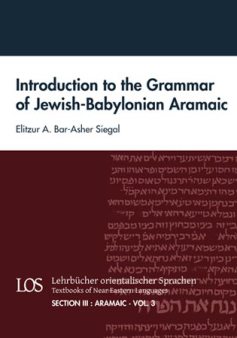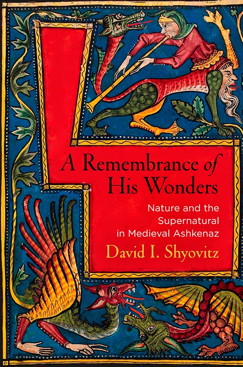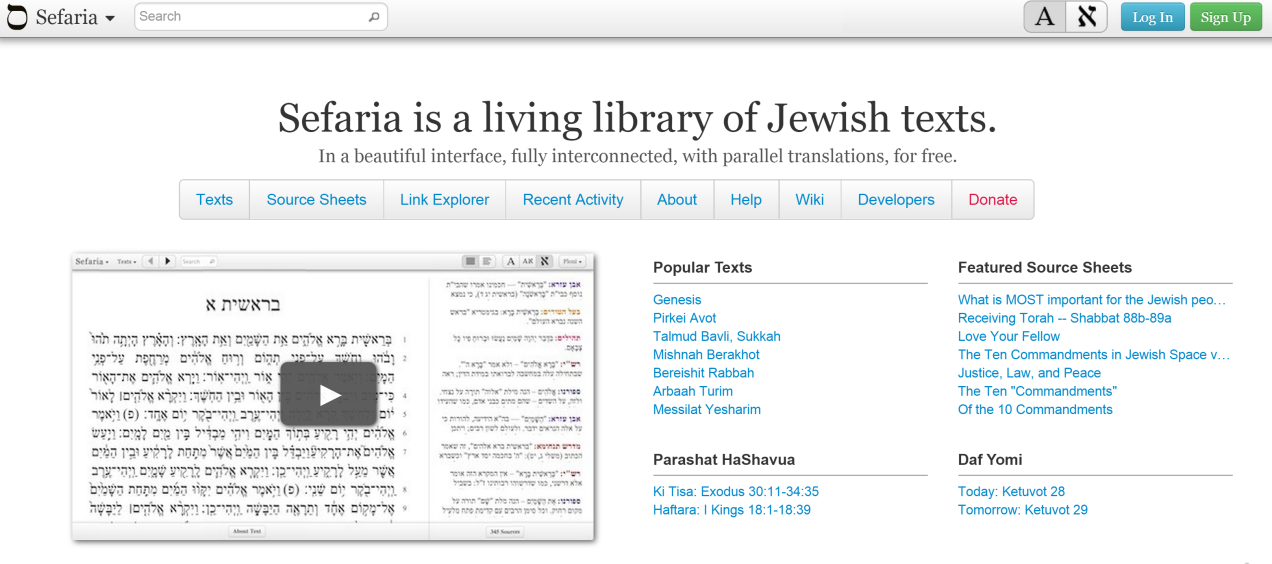Elitzur Bar-Asher Siegal, Introduction to the Grammar of Jewish Babylonian Aramaic, (Münster: Ugarit-Verlag, 2013) – Reviewed by Aaron Koller
For those interested in the grammar of the Bavli, the past few years have seen a steady stream of important new publications. The book under review here will take pride of place in any serious study of the language, as it is the only volume that presents a full picture of the language. An advanced seminar can now work through Bar-Asher Siegal’s book, pore over Sokoloff’s monumental Dictionary of Jewish Babylonian Aramaic (Baltimore: Johns Hopkins University Press, 2002), study Moshe Morgenstern’s Studies in Jewish Babylonian Aramaic (Winona Lake: Eisenbrauns, 2011; see my review here), and use the series of high-quality publications of magic bowls (many also with the involvement of Morgenstern),[1] and emerge with a good knowledge of the dialect.

Perhaps more, however, students in such a seminar will emerge with a deep sense of the challenges facing researchers of the dialect. Those challenges are well adumbrated in Morgenstern’s volume, and they are addressed in Bar-Asher Siegal’s book throughout. These challenges also make the notion of an introductory grammar to the dialect somewhat problematic from the outset. So while Bar-Asher Siegal’s book is excellent, as will be detailed below, it should also be said that the problems of genre and audience are serious here. The author himself notes at the outset that because of the nature of JBA and our data, it is “difficult to write an introductory grammar book of the sort available for Biblical Hebrew, Biblical Aramaic, Classical Arabic, Classical Greek, Classical Latin, etc.” (§0.8, p. 33).
One of the strengths of the book is its precision, both philological and linguistic. (There is a seven-page “glossary for linguistic terminology” at the end [251-257], apparently reflecting the author’s understanding of the demands he is making of his readers.) While there are exercises for each chapter (found, oddly, at the end of the book in a single bloc (pp. 259-286)), this can be a teaching grammar only for advanced students. But let me be clear: the rigor reflected on every page of the book is to be applauded, even if it makes things complex. The only alternatives, in the current state of our knowledge, are to forego a serious analysis of the language or to rely on the printed editions in all their glorious corruption.
Bar-Asher Siegal’s book relies on original research in the manuscripts of the Bavli and original grammatical analysis by a scholar who moves effortlessly between Semitic philology and linguistics. This is as good as an “introduction to Jewish Babylonian Aramaic” can be, and it is difficult to imagine anyone producing a better grammar of this type until there are qualitative advances in the field of JBA.
Bar-Asher Siegal argues, both in the introduction to the book (pp. 28-31) and in an article published in the same year,[2] that there are no really reliable manuscripts for the Bavli. This is against the methodology preached by Yechezkel Kutscher, which has proven so productive for the Mishnah and the Sifra, in particular. Whereas Morgenstern contends that there are such texts, but they are texts not seriously studied by Kutscher – namely, the Early Eastern manuscripts – Bar-Asher Siegal’s claim is that there are no manuscripts that can be utilized as the “primary texts” due to their exceptional reliability. What that means in practical terms is that each and every linguistic phenomenon, from orthography to morphology to syntax, has to be investigated thoroughly and independently in all of the manuscripts. And the result is that many of the paragraphs in the grammar contain references to textual readings in particular manuscripts.[3]
This position comes as something of a disappointment to textual scholars, who would like to be able to study the reliable manuscripts and be confident in the text found therein. Bar-Asher Siegal’s denial that this is the case means there is no text that can be studied to learn the grammar; there is an inescapable circle of reconstructing the grammar and ascertaining the text. If this were a pure circle, there would be no entry point, of course, and there would seemingly be no reliable criteria for determining which witness to follow on any given feature. We need some place to start. While Morgenstern looks to the EEMs, Eljakim Wajsberg has said that there are some “actually good” manuscripts of the Bavli, but apparently is confident in only two: a Yemenite manuscript in Oxford of Sukkah, and a Geniza fragment of Bava Metsia‘.[4] Even if they are not infallible, these texts give us an entry point into the grammar. Here we have mostly reliable manuscripts that provide some of the needed grammatical data. Using this foundation, Bar-Asher Siegal’s method can then be employed: each feature and phenomenon can be studied throughout all of the witnesses in an effort to write a real grammar.
One of the theoretical points made by the author which constantly accompany the analysis is that the text of the Bavli is a problematic witness for JBA. This is for two reasons. First, the Bavli seems to reflect different dialects. This is true not only in the well-known tractates with a somewhat different grammar;[5] randomly distributed throughout the Talmud are features that ought no co-exist within the same dialect. One example is found in §4.2, #6 (pp. 91-92). Here Bar-Asher Siegal discusses forms such as תלמידיך “your student,” where the singular form shows an unexpected yod before the suffixed possessive pronoun, and תלמידך “your students,” where the plural form does not have the expected yod before the suffixed possessive pronoun. He explains how each form may have developed – the former through reanalysis of the yod as part of the suffix rather than a pluralizing morpheme on the noun, and the latter through a sound change of ay > a before a word-final consonant (/_C#). Bar-Asher Siegal then comments:
If this situation reflects the actual forms of JBA, then clearly the two phenomena could not reflect one stage in one language, since either /y/ elided or its morphological role was reanalyzed. Thus, the various forms should either reflect different historical stages or two dialects. This is another example where JBA regularly reflects more than one linguistics system.
Second, however, and more fundamentally, the Bavli may not reflect JBA because scribes often try to mask developments within colloquial language in their written texts. When manuscripts differ between a more archaic and a later form, it often cannot be known whether the text originally had the older form and this was later mistakenly updated, or whether it original reflected the newer form and was then mistakenly “corrected” to the older form. Bar-Asher Siegal explains carefully (and in more detail than the summary offered here) on p. 30 why this is such a far-reaching problem, and concludes, “we may have to be satisfied with the fact that it is not always possible to determine which phenomenon is original. Often it is only possible to raise the various options regarding each and every form.” Fortunately, much of the time Bar-Asher Siegal does reach a conclusion regarding which form is to be preferred, but this caution is indeed found throughout the book.
After the methodological introduction, the book opens with a paragraph introducing orthography, that ends, “The goal of this section is to provide an overview of the different orthographic practices one will encounter in the manuscripts” (§1.1, p. 37). This makes it clear that beginning Talmudists are not the target audience of the book.[6] But this exemplifies the strengths of the book, as well: the grammar of JBA has never received this thorough and sophisticated a study, and anyone, beginner student to advanced scholar, who studies any section of the book will be enriched by it.
Here and there are claims or analyses with which one could quibble. To take one example, Bar-Asher Siegal discusses the pharygealization of the א in words borrowed into JBA. Following Breuer, he identifies this process in the word Ṭayyi’, for example, which appears as טייעא in JBA. Here it may also be that the ע is the result of a folk etymology, however; in many of the other examples he gives of this phenomenon (§3.1.4, pp. 71-72), one wonders whether the presence of a non-etymological ע simply points to the lack of any opposition between א and ע in the dialect, as he discusses in a different example (עדי “these”) later (§3.3.2.1, p. 81). This is the level at which the criticisms take place, however: building on the wide-ranging and fundamental work offered in this book itself, it may be possible to offer suggestions in different areas.
There are comparisons made throughout the book to other languages. Generally, these comparisons have one of two purposes. Sometimes there is a historical point being made, or implied; this is the case when the comparison is to Mishnaic Hebrew, Mandaic, Syriac, or North Eastern Neo-Aramaic dialects, for example. In such cases, it is likely that when there is similarity there is influence. Comparisons are also made to Akkadian, Greek, and other languages, presumably just for typological purposes (although Akkadian certainly did leave an impression on Eastern Aramaic, including JBA). Cross-linguistic data is put to good use in understanding how some of the distinctive features of JBA developed and are used. One example are the enclitic forms of the pronouns used on participles. Bar-Asher Siegal is able to observe that across languages, it is not uncommon for co-referential (redundant) pronouns to become a copula or a marker of agreement, and the originally dislocated element gain a central role in the clause, so that an originally marked construction becomes unmarked (§4.5.2, pp. 98-99). This allows for a clear presentation of the development of עדיפנא אנא “I am preferable” from an original אנא עדיף אנא.
Beginning in chapter 5 (p. 111), the book focuses on the verb. It should be noted that there is no artificial division found in this book between morphology and syntax, so never is the student asked to memorize forms without being told what function those forms play. As forms are introduced, their roles in the language are made clear, as can be seen in the Table of Contents (available here). At the back of the book (beginning on p. 334), there is an alternative Table of Contents, however, with the subjects arranged in the order one might find them in a traditional grammar: orthography, phonology (vowels, consonants), morphology (nouns, pronouns, verbs), syntax. In both it is clear that syntax plays a much larger role in this grammar than in most “introductory” grammars, especially in the later chapters. Indeed, although Bar-Asher Siegal is gracious in giving credit to early scholars for describing the syntax of JBA, the reader will find sophisticated discussions of many syntactic constructions here. The student of general Semitics may well benefit from these discussions even if only for comparative purposes.
One of the more ambitious parts of the book is a full presentation of the Tense – Aspect – Mood (TAM) system of JBA (§7.2, pp. 162-168). Here Bar-Asher Siegal parts ways with most older presentations, and denies that the prefix conjugation expresses the irrealis mood; he also argues that the verb הו”י, in different forms, serves to mark the tense of imperfective verbs as past or future. As in some of Morgenstern’s work, there is here a constant interplay between the conceptualization of the grammar (here, the TAM system) and the philological work with the manuscripts. It is of critical importance for the broad theory to ascertain whether the proper verbal form in a passage is איעול or עייל, for example, but the theory itself also provides justification for preferring one form (in this case, איעול), so there is something of a feedback loop here, which needs caution but also strengthens the analysis.
Related to the TAM system is the forms of the verb הו”י, and Bar-Asher Siegal deftly shows (§7.2.4.2, pp. 168-170) that the verb went from a fully-conjugated verb in a sentence such as כי הוינן אזלין בתריה דר’ יוחנן “when we were walking after R. Yohanan” (b. Berakhot 23a, in MS M) to being frozen in its 3ms form, such as כי הוה אזלינן בתריה דר’ אלעזר “when we were walking after R. El‘azar” (b. Shabbat 12a). The analysis concludes with the note that cross-linguistically, “loss of agreement is related to cliticization,” and it is therefore possible that הוה had become a tense prefix before the participle, rather than a real verb.
There are stimulating proposals and analyses in every section. Those who put the most into the book will get the most out of it. Following the exercises and the vocabulary sections will enable students to feel quite comfortable with JBA as a language. There are some typographical errors which will hopefully be corrected in future editions, but none that I noticed could create obstacles for learning.
I mentioned earlier that this is the best introduction to JBA with the current state of the field. The field is at a high point now, in terms of the quality, quantity, and sophistication of the research being produced. But it is also now clear what would be needed to usher in a new era of JBA studies: a full critical edition of the Bavli. This would, in light of the discussion above, need to be an eclectic edition, and producing such an edition would perforce generate new linguistic and philological insights at every turn. It would also continue the feedback loop: as our texts get better, the grammar will get better, and as the grammar gets better, both the texts and how well we understand them will improve.
Bar-Asher Siegal’s text ends, rather abruptly, with a quotation from Mo‘ed Qaṭan 28a: רבה הוה קא יתיב קמיה דרב נחמן, חזייה דקא מנמנם “Rabbah was sitting in the presence of Rav Nahman, and saw that he was dozing off.” For anyone with an interest in the Bavli, it will be difficult to doze off in the middle of this book. The rigor and thoroughness make for intellectually stimulating and productive study, and open up new avenues in grammatical and linguistic analysis of the Bavli, that most cherished and most challenging of texts.
___
[1] See Shaul Shaked, James Nathan Ford, and Siam Bhayro, with contributions from Matthew Morgenstern and Naama Vilozny, Aramaic Bowl Spells: Jewish Babylonian Aramaic Bowls (Leiden: Brill, 2013).
[2] See also Bar-Asher Siegal’s more systematic discussion in “Reconsidering the Study of Jewish Babylonian Aramaic- Five Decades After E. Y. Kutscher and his Influential Methodology,” Zeitschrift der Deutschen Morgenländischen Gesellschaft 163 (2013), 341-364.
[3] It should be noted that the book does not contain a list of the manuscripts used or the abbreviations utilized to refer to them; the reader is sent to Sokoloff’s Dictionary for that. While Sokoloff’s foundational position in the study of JBA makes this not unreasonable, it still would have been convenient to include the list in the book.
[4] See Eitan Pinsky, “הגרמטיקליזציה של הפועל הוה בצירוף הוה+בינוני בארמית של התלמוד הבבלי” (MA thesis: Hebrew University, 2013), 10 n. 43.
[5] On which see most thoroughly Yochanan Breuer, “The Babylonian Aramaic in Tractate Karetot according to MS Oxford [Bodl. heb. b. 1],” Aramaic Studies 5 (2007), 1-45.
[6] Even advanced students will have to work hard to follow what is being said in passages such as, “Locative PPC [= predicative possessive construction]. In this type of PPC the PR [= possessor] is encoded as the place where the PD [= possessed] is located. The common construction is structurally an existential sentence with the PD behaving as its subject, and the PR as the location. In JBA the PR follows the preposition ב ‘in’ (§4.6.2.2, p. 107).” The first example given is then לית ביה מיא “It does not have water” (B. Qam. 61a), which seems much simpler than the analysis provided.
Aaron Koller is associate professor of Jewish Studies at Yeshiva University. His most recent book is Esther in Ancient Jewish Thought (Cambridge: Cambridge University Press, 2014).












